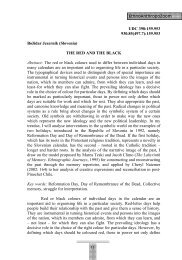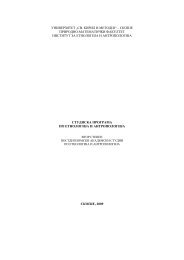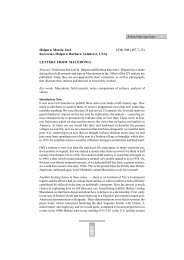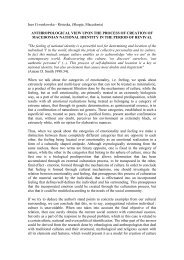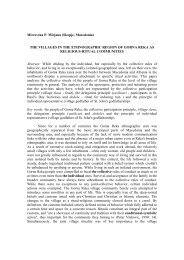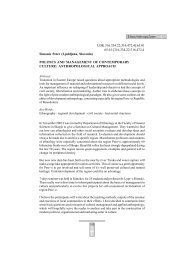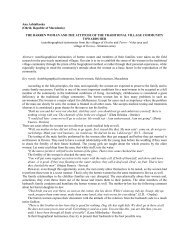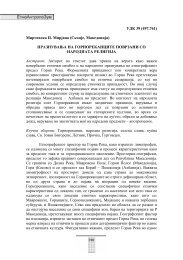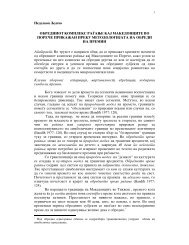Obrembski Jozef, Ritual and Social Structure in a Macedonian Village
Obrembski Jozef, Ritual and Social Structure in a Macedonian Village
Obrembski Jozef, Ritual and Social Structure in a Macedonian Village
You also want an ePaper? Increase the reach of your titles
YUMPU automatically turns print PDFs into web optimized ePapers that Google loves.
achieved through the perversion of some traditional laws. Other types of witchcraft, ever present <strong>in</strong><br />
suspicions, are more serious. They cause death of children, barrenness of women, family quarrels,<br />
marital discord, total ext<strong>in</strong>ction of the family. Basically they consist of antisocial perversion of<br />
ritual acts <strong>and</strong> are contrary <strong>in</strong> every respect to the ma<strong>in</strong> purposes <strong>and</strong> <strong>in</strong>tentions of legitimate<br />
village ritual. Witchcraft, <strong>in</strong> so far as it is practiced, provides a mechanism through which<br />
antagonisms, jealousies <strong>and</strong> animosities, <strong>in</strong>consistent with the precepts of family <strong>and</strong> village<br />
solidarity, f<strong>in</strong>d covert ritual expression lead<strong>in</strong>g to (heir releases. Wide-spread suspicions of<br />
witchcraft <strong>in</strong>dicate-that these antagonistic attitudes are morally repressed <strong>and</strong> projected to others.<br />
The social context of these suspicions is of importance. They orig<strong>in</strong>ate <strong>and</strong> atta<strong>in</strong> high emotional<br />
<strong>in</strong>tensity <strong>in</strong> jo<strong>in</strong>t family relations, as between mother-<strong>in</strong>-law <strong>and</strong> daughter-<strong>in</strong>-law or between jo<strong>in</strong>t<br />
family wives, i.e. women married to brothers liv<strong>in</strong>g together under the zadruga system.<br />
Their reciprocal suspicions of foul play stem from the basic split <strong>in</strong> the jo<strong>in</strong>t family due to its<br />
patril<strong>in</strong>eal emphasis, a dissociation Of its status system from the system of family solidarity. Each<br />
member of the group is placed <strong>in</strong> a situation of divided loyalties: to the group as a whole, to his<br />
own family of orientation, to his own conjugal family <strong>and</strong> to otiier conjugal familes of which the<br />
jo<strong>in</strong>t household is composed. These loyalties are at times at variance with each other. This is<br />
particularly true (19) of women-wives, who arc of course outsiders <strong>in</strong> the group <strong>and</strong> whose<br />
sentimental family attachments do not co<strong>in</strong>cide with those of their husb<strong>and</strong>s. They are restricted to<br />
their own conjugal unit, <strong>and</strong> loyalty to the group as a whole <strong>and</strong> to its "<strong>in</strong>ner circle," <strong>in</strong> which<br />
authority is vested, is never perfect.<br />
They represent centrifugal tendencies <strong>in</strong> the group, generat<strong>in</strong>g antagonisms <strong>and</strong> rivalries, not to be<br />
expressed <strong>in</strong> overt behavior. With the growth <strong>and</strong> ag<strong>in</strong>g of the jo<strong>in</strong>t family, <strong>and</strong> with the decreas<strong>in</strong>g<br />
solidarity of its <strong>in</strong>ner circle <strong>and</strong> the <strong>in</strong>creas<strong>in</strong>g solidarity of its component conjugal units, these<br />
tendencies lead, f<strong>in</strong>ally, to the division of the jo<strong>in</strong>t household. The divisions are carried out <strong>in</strong> an<br />
atmosphere of quarrels <strong>and</strong> sometimes to the accompaniment of reciprocal accusations of<br />
witchcraft. "Women divide the family."<br />
The association of women with witchcraft is consistent both with the general pattern of the<br />
allocation of ritual roles favor<strong>in</strong>g women <strong>and</strong> also with the <strong>in</strong>ferior status they occupy <strong>in</strong> the village<br />
<strong>and</strong> the family.<br />
Summary<br />
The question of how religion adds to group cohesion is approached by focus<strong>in</strong>g analysis on the<br />
relation between the socjal structure <strong>and</strong> the organization of activities. Use is made of a concept of<br />
"religious community," an entity separate <strong>and</strong> dist<strong>in</strong>ct from "secular community. "<br />
In the village of Voltche, Macedonia, the religious community is not (20) a highly structured group.<br />
There is no village priesthood as such <strong>and</strong> no formal organisation or tak<strong>in</strong>g care of the religious life<br />
of the local group. The "religious community" is an analytic abstraction from the total culture<br />
pattern. It consists of <strong>in</strong>terrelated systems of ritual activities <strong>and</strong> correspond<strong>in</strong>g beliefs, attitudes<br />
<strong>and</strong> sentiments shared by villagers.<br />
The organization of ritual activities articulates with the social structure. The emphasis of the unity<br />
of the village groups the importance of its patril<strong>in</strong>eage system, the focal position of the jo<strong>in</strong>t family,<br />
<strong>and</strong>, f<strong>in</strong>ally, bilateral family <strong>and</strong> k<strong>in</strong>ship relations. A marked feature is the predom<strong>in</strong>ant duty played



